Complete Solutions to EXERCISE of chapter Anatomy of Flowering Plants of Class 11 book with complete answers and questions
| Class 11 | BIOLOGY |
| Chapter | Anatomy of Flowering Plants |
| MAXIMUM PUBLICATION | EXERCISE |
| Number Of Questions | 100 |
| Academic Year | 2023-24 |
Both apical and intercalary meristems are which meristems
View SolutionSclerieds present in
View SolutionWhich of the following condition of xylem is present in both monocot and dicot stems
View SolutionBark does not include
View SolutionWhich is not a living tissue?
View SolutionWhat is the cells that make the leaves curl in plants during water stress?
View SolutionWhat part of the plant would show the following:
Radial vascular bundle
polyarch xylem
Well developed pith
View SolutionFill in the blank
Apical meristem for elongation of stem,Lateral meristem for__________
View SolutionWhile analysing the anatomy of a given slide,phloem,cambium and xylem are present . Identify the material.
View SolutionTissue are specialised to perform mechanical function have thickening at corners, living and cellulosic .Name it.
View SolutionWhat does the fascicular cambium gives rise to?
View SolutionWhich type of meristems can be classified on the basis of positions in the plant body?
View SolutionFind the odd one and give: Phellem,Phellogen,Phloem,Phelloderm
View SolutionFill in the blank
Stem :Endarch :: Root : __________
View SolutionFill in the blank
interfascicular cambium: secondary xylem:: cork cambium:__________
View SolutionActivity of cambium is different in two seasons and xylem vessels formed have narrow and widal lumens. Give the type of wood formed during the different seasons.
View SolutionWhat use are phloem fibres put to?
View SolutionIdentify the plant grow from the data given below:
habitat tree
xylem vessels present
absence of companion cell in phloem
no fruits
View SolutionRamu observed the growth of a plant in his garden .He realised that the plant grow both in length and width. Name the tissue responsible for the growth of the plant
View SolutionA cross-section of of plant materials show the following anatomical features under microscope.
Vascular bundles are radially arranged .
To which organ should it be assigned? Four xylem strands with exarch condition of the protoxylem. To which organ should it be assigned? Edit
View SolutionA cross-section of of plant materials show the following anatomical features under microscope.
Vascular bundles are radially arranged .
To which organ should it be assigned? Four xylem strands with exarch condition of the protoxylem. To which organ should it be assigned? Edit
View Solutionthe transverse section of a plant material shows the following anatomical feature:
Vascular bundles are conjoint, scattered and surrounded by sclrenchymatous bundle sheaths.
Phloem parenchyma is absent . What will you identify it as?
View Solutionthe transverse section of a plant material shows the following anatomical feature:
Vascular bundles are conjoint, scattered and surrounded by sclrenchymatous bundle sheaths.
Phloem parenchyma is absent . What will you identify it as?
View SolutionA cross-section of of plant materials show the following anatomical features under microscope.
Vascular bundles are radially arranged .
To which organ should it be assigned? Four xylem strands with exarch condition of the protoxylem. To which organ should it be assigned? Edit
View SolutionA cross-section of of plant materials show the following anatomical features under microscope.
Vascular bundles are radially arranged .
To which organ should it be assigned? Four xylem strands with exarch condition of the protoxylem. To which organ should it be assigned? Edit
View SolutionDuring the secondary thickening of a dicot stem, from the outer cotical region, a meristematic tissue is developed. Name this tissue and write the function of it.
View SolutionAnalyse the table and arrange the matter is an appropriate order.
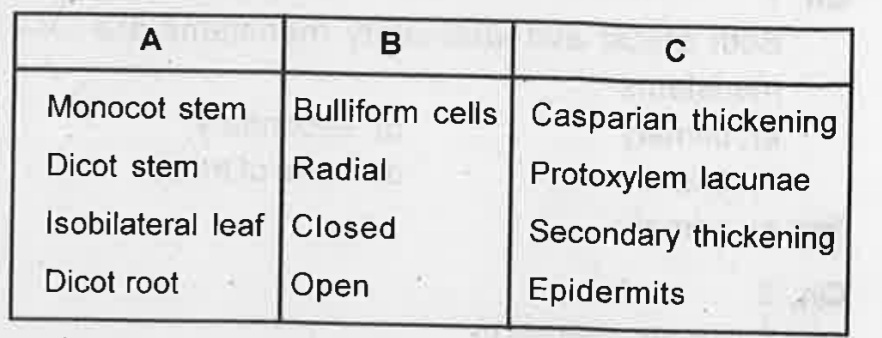
View SolutionDifferentiate the following characters of dicot stem and monocot stem.
Differentiated cortex, Protoxylem lacuna present ,open bundle, bundle Sheath, starch sheath, sclerenchymatous hypodermis, scattered bundles,V.Bs. arranged in ring, closed bundle, phloem parenchyma absent , presence of pith, collenchymatous hypodermis.
View SolutionXylem is the complex tissue that transport water in plants.
Name the main components of xylem. Which of these is mostly likely suitable for conducting water?
View SolutionXylem is the complex tissue that transport water in plants.
Name the main components of xylem. Which of these is mostly likely suitable for conducting water?
View SolutionExamine the anatomy of two plans.
Xylem vessels and tracheids are seen.
Xylem vessels absent and tracheids present.
View SolutionExamine the anatomy of two plans.
Xylem vessels and tracheids are seen.
Xylem vessels absent and tracheids present.
View SolutionIdentify the figure A and B and differentiate between A and B.
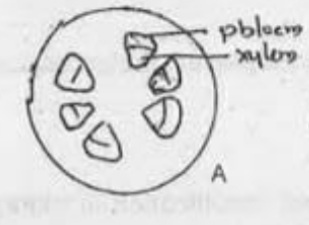

View SolutionPhloem is called the complex tissue while parenchyma is a simple tissue. Make the differences.
View SolutionWhen the cross selection of a stem was examined, a student could notice collenchymatous hypodermis, Limited number of open vascular bundles, cortex, endodermis and pith.
(1) Identify the material.
(2) Draw the diagram of the material showing these parts and label.
View SolutionWhen the cross selection of a stem was examined, a student could notice collenchymatous hypodermis, Limited number of open vascular bundles, cortex, endodermis and pith.
(1) Identify the material.
(2) Draw the diagram of the material showing these parts and label.
View SolutionObserve the diagrams and identify the tissue types.
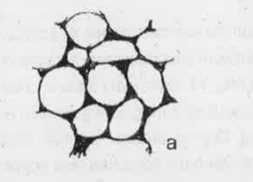
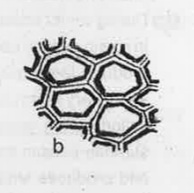
View SolutionAnalyse the table and arrange the matter is an appropriate order.

View SolutionWhile doing anatomy practical, students observe ten following characters:
(i) Undifferentiated ground tissue.
(ii) Numerous vascular bundles and are scattered.
(iii) Sclerenchymatous hypodermis.
(iv) Presence of bundle sheath.
Identify the material. Write any one example of a plant having such characters.
View SolutionWhile doing anatomy practical, students observe ten following characters:
(i) Undifferentiated ground tissue.
(ii) Numerous vascular bundles and are scattered.
(iii) Sclerenchymatous hypodermis.
(iv) Presence of bundle sheath.
Identify the material. Write any one example of a plant having such characters.
View SolutionWhat is the function of phloem parenchyma?
View SolutionActivity of cambium is different in two seasons and xylem vessels formed have narrow and widal lumens. Give the type of wood formed during the different seasons.
View SolutionMention the characteristic features of sieve tube members.
View SolutionIt is difficult to open and close wooden doors and windows during rainy season.
What is the reason?
View SolutionHeart wood is resistant to micro organisms. Justify the statement.
View SolutionSimple tissues that perform mechanical support in plants and usually dead tissues.
Name the living simple tissue that provides mechanical support to plant organs. In which category of plants(dicots/monocots) do they found?
View SolutionWhat is present on the surface of the leaves which helps the plant prevent loss of water but is absent in roots?
View SolutionWhat is the epidermal cell modification in plants which prevents water loss?
View SolutionFind the odd one and give: Phellem,Phellogen,Phloem,Phelloderm
View SolutionA transverse section of the trunk of a tree shows concentric rings which are known as growth rings. How are this rings formed? What is the significance of these rings?
View SolutionWhile eating peach or pear it is usually seen that some stone like structures get entangled in the teeth, what are these stone like structures called?
View SolutionWe cannot find the woody trunk in monocot plants. Why?
View SolutionDifferentiate the following characters of dicot stem and monocot stem.
Differentiated cortex, Protoxylem lacuna present ,open bundle, bundle Sheath, starch sheath, sclerenchymatous hypodermis, scattered bundles,V.Bs. arranged in ring, closed bundle, phloem parenchyma absent , presence of pith, collenchymatous hypodermis.
View SolutionDifferentiate the following characters of dicot stem and monocot stem.
Differentiated cortex, Protoxylem lacuna present ,open bundle, bundle Sheath, starch sheath, sclerenchymatous hypodermis, scattered bundles,V.Bs. arranged in ring, closed bundle, phloem parenchyma absent , presence of pith, collenchymatous hypodermis.
View SolutionThe product of photosynthesis is transported from the leaves to various parts of the plants and stored in some cell before being utilised. What are cells tissues that store them?
View SolutionName the kind of vascular bundle in Fig. a and b.

View SolutionHeart wood is resistant to micro organisms. Justify the statement.
View SolutionCambial ring is responsible for the formation of secondary vascular tissues both in Dicot stem and Dicot root. Differentiate the origin of cambial ring in Dicot stem and Dicot root.
View SolutionGive reason
(a) Grittiness nature of sapola fruit pulp.
(b) Increase thickness of stem in Teak and not in coconut.
View SolutionGive reason
(a) Grittiness nature of sapola fruit pulp.
(b) Increase thickness of stem in Teak and not in coconut.
View SolutionMatch the following.
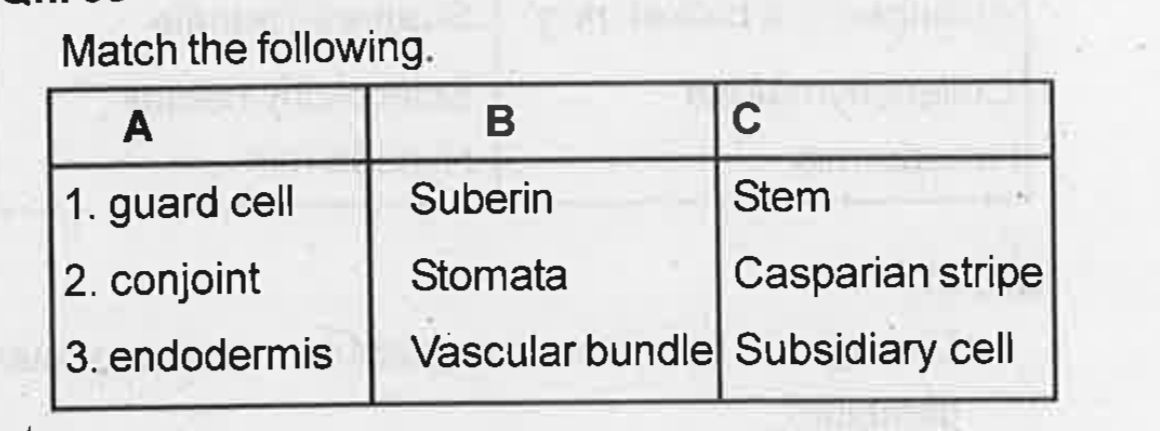
View SolutionYou may have observed droplets of water at the tip of the leaves of grasses during early morning. Your sister told its dew drop.
As a science student do you agree with her? Explain. Compare this with the process of transpiration.
View SolutionActivity of cambium is different in two seasons and xylem vessels formed have narrow and widal lumens. Give the type of wood formed during the different seasons.
View SolutionDifferentiate the following characters of dicot stem and monocot stem.
Differentiated cortex, Protoxylem lacuna present ,open bundle, bundle Sheath, starch sheath, sclerenchymatous hypodermis, scattered bundles,V.Bs. arranged in ring, closed bundle, phloem parenchyma absent , presence of pith, collenchymatous hypodermis.
View SolutionFill in the blank
interfascicular cambium: secondary xylem:: cork cambium:__________
View SolutionIdentify the following diagram and write its function.

View SolutionWhere are companion cells located in the flowering plants? What are their functions?
View SolutionXylem is the complex tissue that transport water in plants.
Name the main components of xylem. Which of these is mostly likely suitable for conducting water?
View SolutionFill in the blank
Stem :Endarch :: Root : __________
View SolutionIf one debarks a tree,what parts of the plant is being removed?
View SolutionSome anatomical details of a material are given below
vascular bundles are conjoint and open, medullary rays are present, hypodermis collenchymatous, cortex heterogenous.
Identify the material. Name the tissue given above from which interfascicular cambium develops during secondary growth.
View SolutionSome anatomical details of a material are given below
vascular bundles are conjoint and open, medullary rays are present, hypodermis collenchymatous, cortex heterogenous.
Identify the material. Name the tissue given above from which interfascicular cambium develops during secondary growth.
View SolutionDuring the secondary thickening of a dicot stem, from the outer cotical region, a meristematic tissue is developed. Name this tissue and write the function of it.
View SolutionDistinguish between heartwood and sapwood.
View SolutionA portion of transverse section of maize stem is shown in the diagram. Label a,b,c,d,e,f,g,h and i

View SolutionDistinguish between heartwood and sapwood.
View SolutionFill in the blank
Stem :Endarch :: Root : __________
View SolutionMatch the column A with B and C .
A (Collenchyma , Cambium, Sieve tube) B(Lateral meristem, Companion cell, Thickened at corners) C (Food Conduction, Hypodermis of dicot stem, secondary growth)
View SolutionMatch the following :
(Column A) - Nostoc, Gonyaulax, Chlorella, Cycas, Rhizophora, Funaria
(Column B) - Protonema, respiratory root, red tide, Space travelers, heterocyst, Coralloid root
View SolutionGrasses are capable of regeneration in spite of continuous grazing by cattle. Suggest the reason for it.
View SolutionIn most woody trees, epidermis breaks to form a lens shape opening. Name this opening that permits gaseous exchange.
View SolutionYou may have observed droplets of water at the tip of the leaves of grasses during early morning. Your sister told its dew drop.
As a science student do you agree with her? Explain. Compare this with the process of transpiration.
View SolutionYou may have observed droplets of water at the tip of the leaves of grasses during early morning. Your sister told its dew drop.
As a science student do you agree with her? Explain. Compare this with the process of transpiration.
View SolutionWhat is the cells that make the leaves curl in plants during water stress?
View SolutionTeacher asked Gopi to name the layer from which root hairs and lateral roots arise respectively.
View SolutionIn an anatomy lab,Ramu and Salim were taking transverse sections of two specimens A and B respectively. Their observations are given in the table. Complete the table.
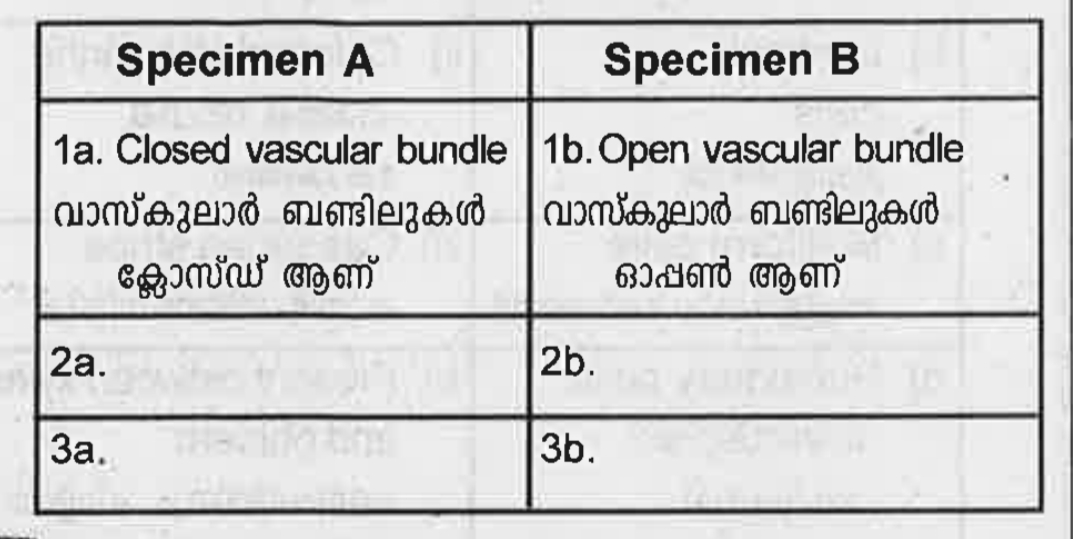
View SolutionThe following is a list of characteristics features of angiosperms and gymnosperms. Those characters that belong to gymnosperms.
(a) Tracheids alone from the conducting elements in xylem
(b) production of fruits.
(c) naked seeds
(d) cones are seen
(e) flowers absence
(f) xylem mainly contains vessel
(g) double fertilization present
View SolutionCambial ring is responsible for the formation of secondary vascular tissues both in Dicot stem and Dicot root. Differentiate the origin of cambial ring in Dicot stem and Dicot root.
View SolutionCambial ring is responsible for the formation of secondary vascular tissues both in Dicot stem and Dicot root. Differentiate the origin of cambial ring in Dicot stem and Dicot root.
View SolutionSome tissues in plants are not able to divide further.
(a) Suggest the name of such tissues.
(b) Give any three examples.
(c) List the difference between epidermal tissue system of roots and leaves.
View SolutionSome tissues in plants are not able to divide further.
(a) Suggest the name of such tissues.
(b) Give any three examples.
(c) List the difference between epidermal tissue system of roots and leaves.
View SolutionSome tissues in plants are not able to divide further.
(a) Suggest the name of such tissues.
(b) Give any three examples.
(c) List the difference between epidermal tissue system of roots and leaves.
View SolutionName the three basic tissue systems in the flowering palnts. Give the tissue names under each system.
View Solutionthe transverse section of a plant material shows the following anatomical feature:
Vascular bundles are conjoint, scattered and surrounded by sclrenchymatous bundle sheaths.
Phloem parenchyma is absent . What will you identify it as?
View Solutionthe transverse section of a plant material shows the following anatomical feature:
Vascular bundles are conjoint, scattered and surrounded by sclrenchymatous bundle sheaths.
Phloem parenchyma is absent . What will you identify it as?
View SolutionPhloem is called the complex tissue while parenchyma is a simple tissue. Make the differences.
View SolutionInterfascicular cambium is a
View SolutionIn an annual ring,the light coloured part is known as
View SolutionThe layer of cell outside the phloem meant for giving rise to the root branches is called
View SolutionCork cambium of dicot originates from
View Solution
EXERCISE questions and complete solutions for chapter Anatomy of Flowering Plants of MAXIMUM PUBLICATION of Class 11